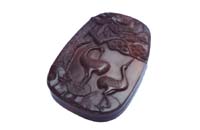 Inkstone
Inkstone
 To use the traditional ink stick, an inkstone is required. As the name suggests, most inkstones are made of stone. The stone used must be of relatively fine whetstone materials so the bristles of the brush pen are not damaged and to facilitate the grinding of the ink stick could.
To use the traditional ink stick, an inkstone is required. As the name suggests, most inkstones are made of stone. The stone used must be of relatively fine whetstone materials so the bristles of the brush pen are not damaged and to facilitate the grinding of the ink stick could.
In the ruins of primitive times, archaeologists discovered simple stone ink-slab that needed a pestle to grind pigments. After artificial ink-sticks appeared in Han, pestle gradually disappeared. There were pottery ink-slab, lacquer ink-slab and copper ink-slab in the Han Dynasty as well as stone ink-slab. Among the stone ink-slabs, the round tripod pieces were the most typical. During the Wei, Jin and Northern-and-Southern Dynasties, round tripod porcelain ink-slabs were in vogue. It was in the Sui and Tang dynasties that "Piyong" inkstone having circular legs appeared.
A little water is added to the inkstone, and the ink stick is ground. The result is ink, and the inkstone acts as an inkwell. Inkstones are extremely durable. In ancient times, artisans would have their names or other words engraved on their inkstones to be passed on to future generations.
 Other tools of calligraphy
Other tools of calligraphy
Ancient tools of calligraphy included not only brush, ink-stick, paper and inkstone, but also some accessories such as penholder, brush pot, ink box, paperweight,seal, seal box. The raw materials of these tools varied from pottery, porcelain, copper, iron, lacquer, wood, bamboo, stone, jade, jadeite, agate and coral.
Author: Jessie
